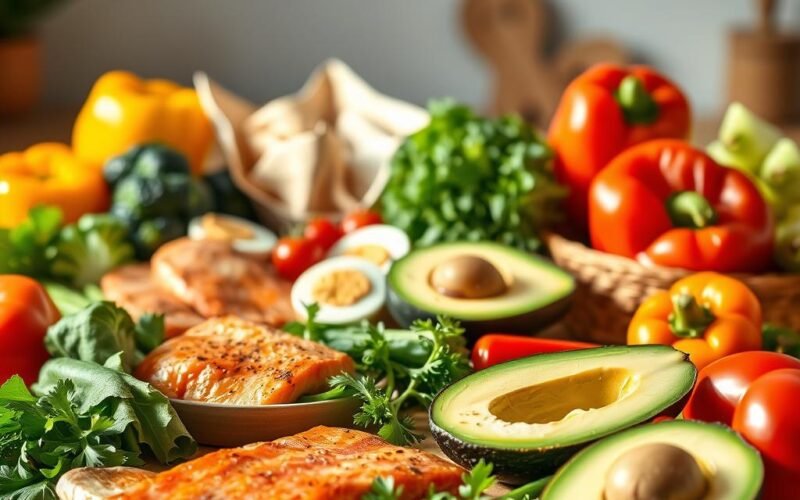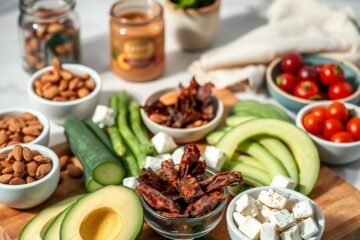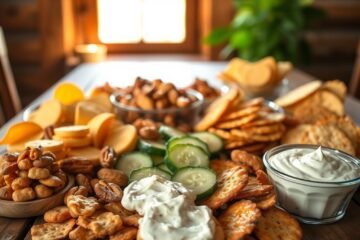Starting a low-carb, high-fat diet can greatly benefit your golden years. This keto meal plan for seniors is designed to be simple, boost energy, and improve overall health for those 60 and older.
As you get older, your body needs different nutrients. Our 7-day plan meets these needs in a way that’s easy and fun to follow. It’s tailored for the unique changes that happen as you age.
Senior nutrition on keto focuses on key nutrients while keeping carbs low, around 20-50 grams a day. This helps your body use fat for energy, which can help with weight management.
Many seniors find they feel clearer mentally, have more energy, and better blood sugar control on this diet. Each recipe in this guide uses healthy keto foods for aging adults to make sure you get the most nutrition with the least effort.
Are you ready to change how you view food and find a new way to nourish yourself? Let’s see how this week-long plan can help you flourish.
The Benefits of Keto for Aging Adults
Starting a ketogenic diet after 60 can bring big benefits. It helps tackle health issues that come with aging. The keto diet for seniors over 60 changes how your body uses energy. It uses fats instead of carbs, making ketones that help with many health problems.
How Keto Supports Senior Health
Ketosis makes ketones, which give your brain energy. This can keep your mind sharp and support brain health as you get older. Many seniors say they feel more mentally clear and focused on keto.
Using fats for energy means no energy crashes. Keto for age-related conditions keeps your energy steady all day. This helps fight off the tiredness that often comes with aging.
It also helps control blood sugar. Eating fewer carbs means your blood sugar stays more stable. This is key for seniors with or at risk of diabetes.
What Makes This 7-Day Plan Different
This plan focuses on nutrient-rich foods, not just counting calories. It’s designed for keto for elderly beginners to be easy to follow and digest.
It also meets the changing needs of older adults. It balances fats, proteins, and carbs. It includes more protein for muscle health and healthy fats for joints and brain.
| Feature | Standard Keto Approach | Senior-Focused Keto Plan |
|---|---|---|
| Protein Content | Moderate (20-25%) | Higher (30-35%) for muscle preservation |
| Food Preparation | Often complex recipes | Simple, easy-to-prepare meals |
| Nutrient Focus | Macronutrient ratios | Micronutrient density and bioavailability |
| Meal Frequency | Often includes intermittent fasting | Regular, consistent meals for stability |
Why Keto Works for Seniors Over 60
Seniors in their golden years find the ketogenic diet helpful. It targets age-related challenges. The diet’s benefits are tailored to the changes that come with aging.
Brain Health and Cognitive Benefits
As we get older, our brains use less glucose for energy. The ketogenic diet offers ketones as an alternative fuel. This may support brain function.
Ketones easily reach brain cells, giving them quick energy. Many seniors notice better mental clarity, focus, and memory after starting keto.
The brain prefers ketones for energy. They provide more efficient energy per unit oxygen used. This may protect aging brain cells from damage.
Energy Levels and Metabolism
Metabolic slowdown is common in seniors. The keto diet helps by:
- Keeping blood sugar stable to avoid energy crashes
- Using fat stores for steady energy
- Lowering inflammation that causes fatigue
Seniors often find more consistent energy with balanced keto for retirement age. They no longer experience energy highs and lows from carb-heavy diets.
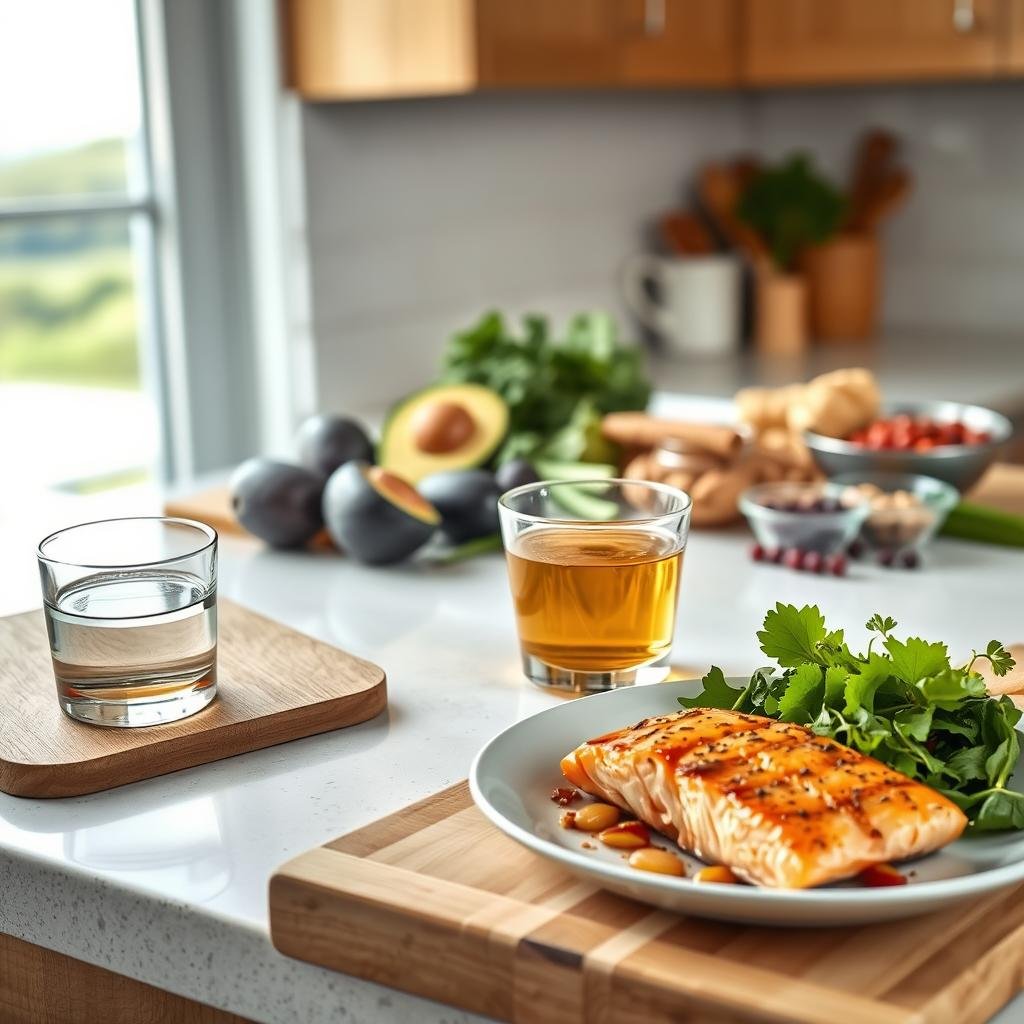
Weight Management Without Extreme Restriction
Keto is appealing for weight management in seniors. It focuses on feeling full, not counting calories.
The diet’s high fat content keeps you full longer. This makes keto and senior weight management easier, as you’re less hungry between meals.
During ketosis, you feel less hungry because fat is metabolized longer than carbs. This natural way of feeling full helps manage weight without strict calorie counting.
Blood Sugar Regulation and Diabetes Management
Seniors with type 2 diabetes or prediabetes benefit from keto. It reduces carbs, lowering blood sugar and insulin needs.
Many older adults can reduce their diabetes meds with keto (with doctor’s guidance). The diet helps avoid blood sugar spikes and crashes, common in aging.
This stabilization of blood sugar also improves energy, mood, and reduces inflammation. These are key for a good quality of life in your senior years.
Nutritional Needs That Change With Age
As we age, our bodies change how they use nutrients. This means we need to adjust our diet. For seniors on keto, knowing these changes is key to staying healthy.
Protein Requirements for Maintaining Muscle Mass
With age, our bodies lose muscle easier. This is called sarcopenia. Seniors need more protein, about 1.0-1.2 grams per kilogram of body weight every day.
On keto, aim for 60 grams of protein a day from good sources. Eating protein at every meal helps keep muscles strong. This way, you meet your protein needs without going over on carbs.
Great keto protein choices are eggs, fatty fish, and meats with skin. Also, don’t forget about plant-based options like hemp seeds and lupini beans. They add fiber and keep carbs low.
Healthy Fats for Joint and Brain Health
Healthy fats are key for seniors, helping with joints and brain health. Omega-3s are great for reducing inflammation and easing joint pain.
For a healthy brain, mix different fats in your meals. Avocados, olive oil, and fatty fish are good choices. DHA in salmon and sardines is great for brain health.
Micronutrients to Prioritize on Keto
On keto, seniors need to focus on certain nutrients. Calcium is important for bones, and you need about 1200mg daily. Vitamin D is also vital for calcium absorption and immune health.
Magnesium and potassium are important for heart health and preventing muscle cramps. These are key, even more so for seniors on certain medications.
| Nutrient | Daily Need for Seniors | Keto-Friendly Sources | Benefits |
|---|---|---|---|
| Protein | 60-90g (1.0-1.2g/kg) | Eggs, fatty fish, poultry | Preserves muscle mass, supports immunity |
| Calcium | 1200mg | Cheese, sardines, leafy greens | Maintains bone density, nerve function |
| Vitamin D | 800-1000 IU | Egg yolks, salmon, sunshine | Enhances calcium absorption, mood regulation |
| Magnesium | 320-420mg | Pumpkin seeds, avocado, spinach | Supports heart rhythm, reduces cramps |
Important Precautions Before Starting Keto
Starting a keto diet as a senior needs careful planning. It’s important to know about health issues that come with age. The keto diet can be great for older adults, but it’s key to start safely and comfortably.
Medical Consultation: Who Should Be Extra Cautious
Before starting a low-carb diet for older adults, talk to your doctor. This is even more important if you have health problems like:
- Kidney or liver disease
- Heart conditions
- Type 1 or Type 2 diabetes
- High blood pressure needing medicine
- Gallbladder issues
Your doctor will check your medicines. They might need to change when you start keto. Ask about how ketosis affects your health and what to watch for.
Transitioning Gradually to Avoid “Keto Flu”
Many keto for elderly beginners cut carbs too fast. This can cause “keto flu” with symptoms like headaches and brain fog.

Instead, start by cutting out sugary foods and refined carbs slowly. Reduce starchy veggies and grains over 2-3 weeks. This helps your body adjust to using fat for energy.
Hydration and Electrolyte Balance
The keto diet can make you lose more water. For seniors, staying hydrated is even more critical.
Drink lots of water and watch your electrolytes. When you cut carbs, your body loses more sodium and other minerals. Here’s how to stay balanced:
- Add a pinch of salt to your water or food
- Eat foods rich in magnesium like leafy greens and nuts
- Include potassium in foods like avocados and some low-carb veggies
Common Keto Mistakes Seniors Should Avoid
Be careful of these common mistakes on your keto diet journey:
- Eating too few calories can cause weight loss and muscle loss
- Not getting enough fiber can worsen constipation
- Relying too much on processed “keto-friendly” foods with unhealthy additives
- Eating too much dairy, which can upset your stomach
- Ignoring the importance of regular meal times
Keto is not about cutting out food but making smart choices. With the right preparation and care, most seniors can safely and effectively follow a ketogenic diet.
Essential Keto Staples for Your Weekly Shopping List
Shopping for a senior-friendly keto list makes meal prep easier. It helps keep your diet on track, even when energy or mobility is low. Here are the key items to stock your keto kitchen.
Pantry Essentials
Your keto pantry is key for meals. Keep these items on hand for easy access:
- Healthy Oils: Extra virgin olive oil, avocado oil, and coconut oil
- Nuts and Seeds: Almonds, walnuts, macadamia nuts, chia seeds, and flaxseeds
- Alternative Flours: Almond flour, coconut flour, and ground flaxseed
- Canned Goods: Tuna, salmon, sardines, and olives
- Condiments: Sugar-free mayonnaise, mustard, and vinegars
Refrigerator Must-Haves
Fresh ingredients add variety and nutrients to your meals. Focus on these fridge staples:
- Proteins: Eggs, chicken, grass-fed beef, and pork
- Dairy: Butter, heavy cream, full-fat yogurt, and cheeses like cheddar and mozzarella
- Vegetables: Leafy greens, broccoli, cauliflower, zucchini, and bell peppers
- Fruits: Avocados, lemons, limes, and small amounts of berries
Freezer-Friendly Keto Foods
Your freezer can help reduce shopping trips. These items freeze well for quick meals:
- Portioned Meats: Individual chicken breasts, ground beef patties, and fish fillets
- Fatty Fish: Wild salmon, mackerel, and herring
- Vegetables: Spinach, cauliflower rice, and stir-fry mixes (check for added starches)
- Berries: Strawberries, blueberries, and raspberries in small portions
Budget-Friendly Options for Fixed Incomes
Keeping to a keto diet doesn’t have to be expensive. Here are ways to save money:
| Strategy | Examples | Benefits |
|---|---|---|
| Seasonal Shopping | Local vegetables in season, farmers markets | Lower prices, better flavor, higher nutrients |
| Protein Alternatives | Eggs, canned fish, chicken thighs | Less expensive than premium cuts, yet keto-friendly |
| Bulk Purchasing | Family packs of meat (portion and freeze), nuts | Lower per-unit cost, fewer shopping trips |
| Store Brands | Oils, cheeses, frozen vegetables | Similar quality at reduced prices |
For those with mobility issues or who prefer ease, keto meal delivery is now available. These services offer pre-portioned ingredients or meals that fit keto guidelines. But, they often cost more.
7-Day Keto Meal Plan for Seniors: Daily Breakdown
Discover the joy of keto eating with our 7-day meal plan for older adults. It’s packed with nutritious, easy meals that boost your health and energy. Each day offers breakfast, lunch, dinner, and snacks tailored for seniors.
This meal plan uses familiar foods in a keto way, avoiding complicated recipes. You’ll enjoy comfort food classics that are easy to chew and gentle on your stomach. Let’s dive into a week of delicious keto-friendly meals that keep you energized.
Follow this plan with the senior grocery list and snack ideas from senior snack guide.
Day 1: Getting Started with Simple Meals
Your keto journey starts with simple, easy meals. These recipes require few ingredients and are quick to make. They help you get into the keto lifestyle without stress.
Breakfast: Start with egg muffins with Cheddar cheese, spinach, and sun-dried tomatoes. You can make them ahead and reheat them. For softer food, try scrambling the ingredients.
Lunch: Enjoy a spiced cauliflower soup with bacon pieces. For a veggie option, use tofu instead of bacon. This soup is easy on your stomach and full of nutrients.
Dinner: Try garlic and herb-buttered shrimp with zucchini noodles. This quick meal is full of healthy fats and protein. If you don’t like seafood, use chicken tenders instead.
Snacks: Stay full with roast turkey and cucumber roll-ups or celery with guacamole. These snacks offer protein and healthy fats to keep your energy up.
Day 1 focuses on about 75% fat, 20% protein, and 5% carbs. Meals are timed to help manage medications that need to be taken with food.
Day 2: Introducing More Variety
Day 2 adds more variety to your meals while keeping them simple. You’ll try different proteins, veggies, and healthy fats to keep things interesting.
Breakfast: Enjoy scrambled eggs on sautéed greens with pumpkin seeds. This breakfast is full of nutrients and has a nice crunch from the seeds.
Lunch: Try a chicken mayonnaise salad with cucumber, avocado, tomato, almonds, and onion. This colorful salad offers various textures and flavors while staying keto-friendly.
Dinner: Warm up with a hearty beef stew featuring mushrooms, onions, celery, herbs, and beef broth. This classic comfort food can be made in a slow cooker for ease and tenderness.
Snacks: Munch on olives for a quick fat boost, or blend a smoothie with almond milk, sugar-free nut butter, chia seeds, and spinach for a nutrient-packed treat.
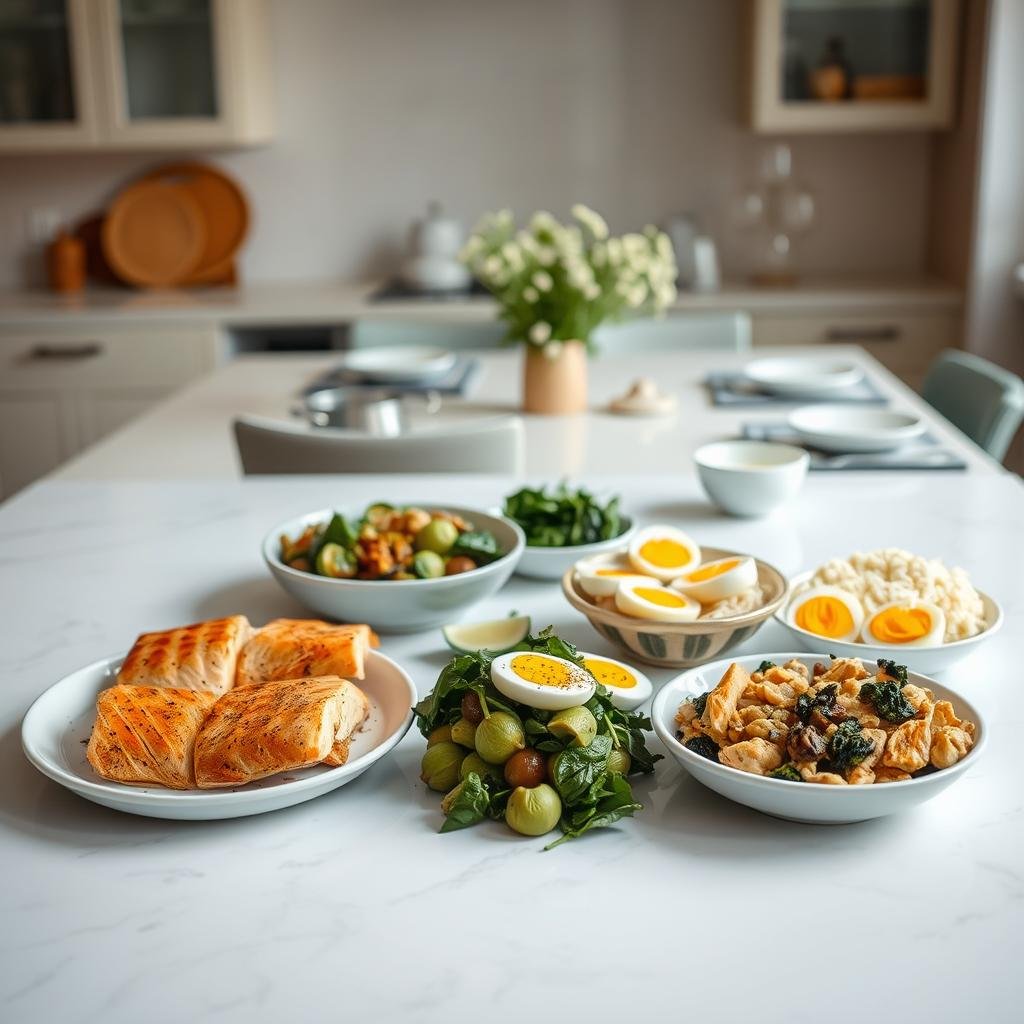
Day 2 keeps the keto macronutrient ratio while introducing new flavors and textures. These senior-friendly keto recipes are satisfying and support your nutritional needs.
Day 3: Focusing on Nutrient Density
Today’s menu highlights meals rich in nutrients seniors often need more of, like calcium, vitamin D, potassium, and magnesium. These nutrients support bone health, immune function, and muscle maintenance.
Breakfast: Try a Greek yogurt parfait with a small handful of berries, chia seeds, and unsweetened coconut flakes. This breakfast is rich in calcium and low in carbs.
Lunch: Enjoy a salmon salad with mixed greens, avocado, and a lemon-dill dressing. Salmon provides vitamin D and omega-3 fatty acids essential for brain and heart health.
Dinner: Savor spinach-stuffed chicken breast with a side of roasted Brussels sprouts. This dinner is rich in potassium and supports heart health and muscle function.
Snacks: Nibble on macadamia nuts and cheese cubes for magnesium and calcium, or try half an avocado sprinkled with everything bagel seasoning.
These nutrient-dense meals help address common deficiencies while following keto principles. Each recipe can be modified for texture preferences or dietary restrictions without losing nutritional value.
Day 4: Midweek Energy Boost
By midweek, many seniors feel a slump in energy. Day 4 features meals designed to combat fatigue with balanced fat and protein ratios for sustained energy throughout the day.
Breakfast: Power up with a keto-friendly smoothie bowl topped with hemp seeds, unsweetened coconut, and a small portion of berries. This breakfast provides quick energy without digestive strain.
Lunch: Enjoy a tuna-stuffed avocado with a side of cucumber slices. This simple lunch requires minimal preparation while delivering protein and healthy fats for sustained energy.
Dinner: Savor herb-roasted chicken thighs with garlic butter cauliflower mash. This comfort food dinner provides ample protein and fat to fuel your evening activities.
Snacks: Keep energy levels stable with deviled eggs or cucumber slices topped with cream cheese and everything bagel seasoning.
Day 4’s meals are timed to provide energy when you need it most, with slightly larger meals during your most active periods and lighter options when you’re less active.
Day 5: Comforting and Heart-Healthy Choices
Today’s meals focus on heart health and digestion-friendly options, ideal for seniors managing blood pressure or cholesterol levels.
Breakfast: Almond Flour Pancakes with Butter and Cinnamon,Top with a few raspberries or sugar-free syrup. Easy to chew and packed with fiber and healthy fats.
Lunch: Egg Salad Lettuce Wraps
Made with boiled eggs, mayonnaise, mustard, chopped celery, and wrapped in romaine or butter lettuce. Add avocado for extra creaminess.
Dinner: Baked Salmon with Lemon & Dill
Side: Steamed asparagus with olive oil, rich in omega-3s and easy to prepare. Great for supporting cognitive and cardiovascular health.
Snacks: Walnuts or pecans (a small handful). Sliced bell peppers with herbed cream cheese
Day 5 is all about gentle and nourishing foods. It includes soft textures and anti-inflammatory foods. The almond flour pancakes are a comforting option without carbs.
Baked salmon is a great source of healthy omega-3 fats. These meals are easy to digest. They’re perfect for supporting heart and joint health.
Day 6: Light & Fresh Meals for Digestion
This day features lighter, fresher meals—perfect for warmer weather or for when appetite is low.
Breakfast: Chia Pudding with Coconut Milk. Prepared overnight and topped with a few blueberries or crushed almonds. High in fiber and very gentle on digestion.
Lunch: Zoodle Chicken Stir-Fry. Made with zucchini noodles, grilled chicken, sesame oil, and stir-fried vegetables like bell peppers and mushrooms. Low-carb, colorful, and easy to digest.
Dinner: Stuffed Bell Peppers (Keto-style). Stuff with ground beef or turkey, cauliflower rice, tomato paste, and spices. Bake until tender and top with cheese.
Snacks: Cheese crisps or Parmesan chips. A few slices of cold roasted chicken or turkey with mustard.
Day 6 brings in fun textures like zoodles and stuffed peppers. These add excitement to meals without extra carbs. The goal is to keep meals full of whole foods, fiber, and quality protein.
This helps with digestion, keeps blood sugar stable, and provides steady energy. It’s all about making meals enjoyable and healthy.
Day 7: Easy Prep and Meal Flexibility
This final day focuses on meals that can be batch-cooked or assembled quickly—ideal for low-energy days.
Breakfast: Keto Egg Bake.A baked dish with eggs, sausage, spinach, and cheese. Make a batch and reheat as needed.
Lunch: Cobb Salad. Includes: grilled chicken, avocado, egg, bacon, lettuce, and blue cheese. Use olive oil and vinegar for dressing.
Dinner: Creamy Broccoli and Cheese Soup. A warm, satisfying soup using heavy cream, cheddar cheese, and steamed broccoli. Use a blender if a smoother texture is preferred.
Snacks: Hard-boiled eggs. Cucumber and avocado slices with olive oil drizzle.
Day 7 wraps up your week with comforting dishes like an egg bake and creamy soup. The Cobb salad brings together fats and protein for a nutrient-rich meal. It’s a great way to end the week, balancing variety, ease, and keto goals.
This meal plan provides about 1,500-1,800 calories daily, suitable for most seniors on a keto diet. You can adjust portion sizes based on your caloric needs and activity level. Remember to drink plenty of water and consider supplements as advised by your healthcare provider.
The easy keto meals for older adults: In this plan require minimal preparation time while delivering maximum nutrition. Many can be prepared in advance or modified for single servings to reduce kitchen time and energy expenditure.
As you progress through the week, you’ll notice how these meals help stabilize your energy levels and potentially improve various aspects of your health. The remaining days of the plan will continue to build on these principles while introducing additional variety and nutrient-dense options.
Remember to listen to your body and adjust portions or ingredients as needed. This flexible approach ensures your keto journey remains sustainable and enjoyable for the long term.
Meal Preparation Strategies for Seniors
For seniors starting the keto diet, meal prep can make cooking fun. By using keto meal prep for the elderly strategies, you save energy and time. You’ll also have healthy meals ready when you need them.
Batch Cooking to Save Energy and Time
Batch cooking is a big help for seniors on keto. Set aside one or two days a week for cooking many meals at once. This way, you spend less time cooking and always have healthy food ready.
Begin with cooking proteins like roasted chicken, ground beef, or baked fish. These can be used in different meals throughout the week. Also, make large batches of keto-friendly sides like roasted veggies or cauliflower rice.
Once cooked, divide your meals into portions. This makes it easy to grab a meal when you’re too tired to cook.
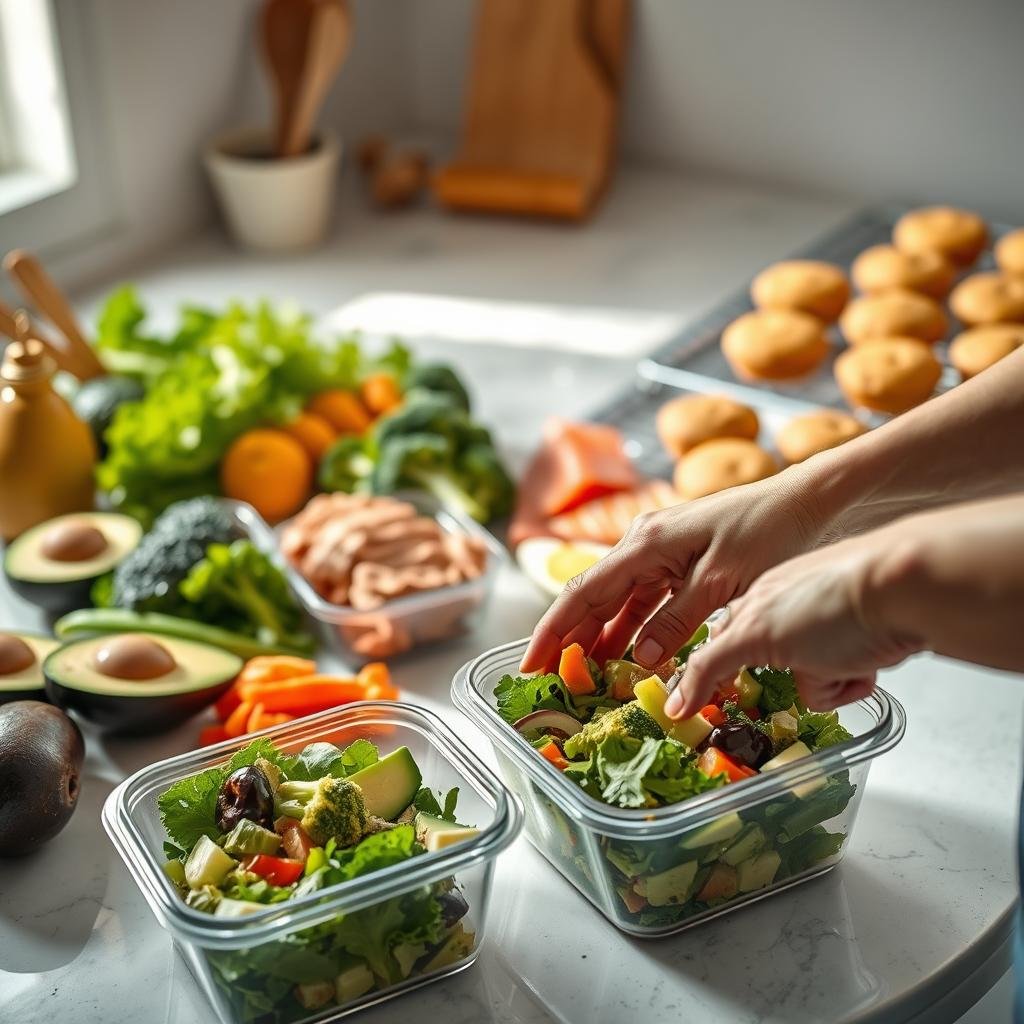
Safe Food Storage Guidelines
Storing food safely is key for seniors, whose immune systems are weaker. Cooked meals should be refrigerated within two hours and eaten in 3-4 days.
Freezing is best for longer storage. Use containers or bags that are safe for the freezer and label them with what’s inside and when. Most keto meals can be frozen for 2-3 months.
When reheating, make sure food is hot all the way through to kill bacteria. A food thermometer is a good investment for safety.
Kitchen Tools That Make Keto Cooking Easier
The right kitchen tools can make low-carb meal prep for seniors easier, even for those with arthritis or less strength.
Consider getting a slow cooker or Instant Pot for easy cooking. Food processors chop veggies quickly, and immersion blenders make soups and sauces easy. Electric can openers and ergonomic utensils help reduce hand strain.
Silicone mats and parchment paper make cleanup easier. Divided containers help with portion control and storage.
Adapting Recipes for Single Servings
Many senior keto recipes serve 4-6 people, leading to waste for singles. Scale down recipes by dividing ingredients by the number of servings. If a recipe can’t be halved (like using half an egg), cook the whole amount and freeze leftovers.
Make a rotating menu of favorite meals to keep things interesting without feeling overwhelmed. Try a “cook once, eat twice” method by using leftovers in new ways—today’s chicken becomes tomorrow’s salad.
| Batch Cooking Strategy | Benefits | Best For | Storage Time |
|---|---|---|---|
| Protein Base Prep | Versatile foundation for multiple meals | Chicken, beef, fish | 3-4 days refrigerated |
| Complete Meal Assembly | Ready-to-eat convenience | Casseroles, stews | 2-3 months frozen |
| Ingredient Preparation | Speeds up daily cooking | Chopped vegetables, herb mixes | 5-7 days refrigerated |
| Freezer Meals | Long-term meal security | Soups, chili, meatballs | 2-3 months frozen |
Managing Common Challenges on the Senior Keto Journey
Starting the ketogenic diet as a senior comes with unique challenges. Low-carb diets for older adults have many benefits. But, some obstacles may need careful solutions to keep you on track.
Dealing with Decreased Appetite
Many seniors feel less hungry as they get older. To stay well-nourished on keto:
- Eat foods high in nutrients and calories like avocados and nuts
- Have five or six small meals instead of three big ones
- Set regular times to eat to keep a routine
- Add healthy fats to make meals more filling without adding carbs
Addressing Taste Changes That Come With Age
Our taste buds change with age. To make your keto-friendly meals for the elderly more flavorful:
- Use herbs like rosemary, thyme, and basil for aroma
- Add umami with mushrooms, aged cheeses, and bone broth
- Use citrus zests and vinegars for a bright taste
- Try different spice blends to find new favorites
Medication Interactions to Be Aware Of
Some medications for seniors can affect a ketogenic diet. Always talk to your doctor about:
- Blood thinners like warfarin and leafy greens
- Diabetes meds that might need to be adjusted
- Blood pressure meds that could change with weight loss
- Cholesterol meds, as your lipid levels may change
Dining Out While Staying Keto-Compliant
Eating out is important for seniors. It shouldn’t stop you from following your keto for age-related conditions plan:
- Look up restaurant menus online before going
- Ask for simple changes like vegetable swaps for starches
- Choose dishes with lots of protein and side salads
- Don’t be afraid to ask about ingredients and cooking methods
- Have a small keto snack before social events to avoid hunger
In your first weeks on keto, drink lots of water and take electrolytes to avoid the “keto flu.” You might need to slow down your exercise while your body gets used to burning fat. Remember, it takes time to adjust to any new diet, so be patient with yourself.
Tracking Your Progress and Celebrating Success
Seniors on a keto diet need to track more than just weight. The keto journey brings many health benefits that aren’t just about the scale. By monitoring different aspects of your health and making adjustments, you can stick to keto nutrition for aging well long-term.
Simple Ways to Monitor Health Improvements
Success on keto shows up in many ways that improve your life. Keep a simple journal to track these changes:
- Energy levels throughout the day
- Sleep quality and duration
- Mental clarity and focus
- Joint comfort and mobility
- Blood pressure readings (if you monitor at home)
Seniors with diabetes can see big improvements in blood sugar levels. Many find they need less medication as their bodies start burning fat instead of glucose.
Take weekly photos instead of daily weigh-ins. Seeing changes in your body can tell a more complete story than just numbers. Celebrate small victories like playing with grandkids without getting tired or going on longer walks without pain.
Adjusting the Plan to Your Individual Needs
The beginner’s guide to keto for seniors is just the start. As you go along, you’ll find what works best for you. Some seniors do well on standard keto, while others need to make adjustments.
If you’re very active, you might need a bit more carbs (30-50g). Or you could try cyclical keto, where you eat more carbs on certain days. Mixing up your meals keeps things interesting and ensures you get all the nutrients you need.
Look for new low-carb products at the grocery store. These can help you stick to your diet and make it more enjoyable, even when you’re craving familiar foods.
When to Consult Your Doctor About Diet Changes
While keto is great for seniors, there are times when you should talk to your doctor:
- Unusual fatigue or dizziness that lasts
- Changes in how your medications work
- Weight loss that happens too fast
- Digestive issues that don’t get better with simple changes
When you see your doctor, bring your tracking journal. This shows the positive changes you’ve made. It helps you have a good conversation about your keto diet tips for older individuals and any needed changes.
Your healthcare team should be your partners in wellness. Many doctors are now familiar with keto’s benefits, like managing diabetes, high blood pressure, and cognitive issues in seniors.
Conclusion
Starting a keto meal plan for seniors is more than just losing weight. It’s about improving your life quality. The right keto diet can increase your energy, support your brain, and manage chronic conditions that come with age.
This 7-day plan is just the beginning. Your body’s needs might change, so you might need to adjust your diet. Many seniors find they love eating healthy keto foods like fatty fish, avocados, and leafy greens.
Changing to a keto diet can be tough at first. Your taste and eating habits have grown over years. Be patient and consider getting help from a healthcare provider who knows about keto and senior nutrition.
Planning your meals carefully is key. It helps keep the right balance of fats, proteins, and carbs. This way, you avoid hunger, get enough fiber, and prevent nutritional gaps.
By starting this keto meal plan, you’re taking a big step towards better health. Your journey to better health starts with small, consistent changes. These changes honor your body’s needs and support your independence and energy for years.

